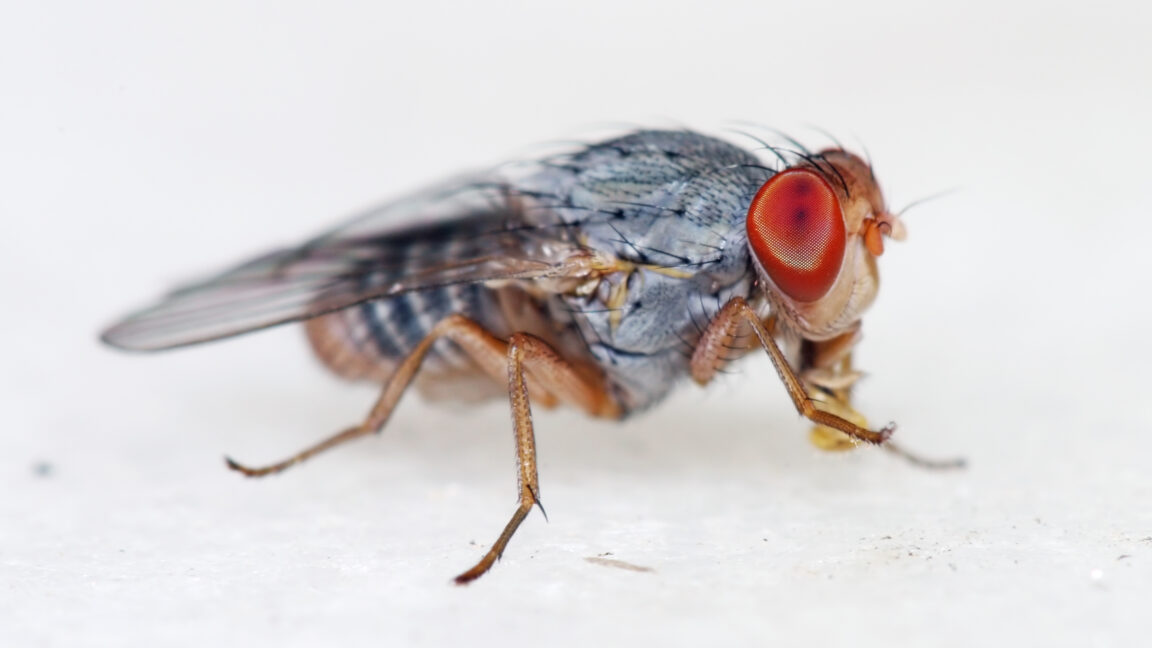Light and smells can turn flies into remote-controlled near-automatons.
Even the tiniest of living things are capable of some amazing forms of locomotion, and some come with highly sophisticated sensor suites and manage to source their energy from the environment. Attempts to approach this sort of flexibility with robotics have taken two forms. One involves making tiny robots modeled on animal behavior. The other involves converting a living creature into a robot. So far, either approach has involved giving up a lot. You're either only implementing a few of life's features in the robot or shutting off most of life's features when taking over an insect.
But a team of researchers at Harvard has recognized that there are some behaviors that are so instinctual that it's possible to induce animals to act as if they were robotic. Or mostly robotic, at least—the fruit flies the researchers used would occasionally go their own way, despite strong inducements to stay with the program.
Smell the light
The first bit of behavior involved Drosophila's response to moving visual stimuli. If placed in an area where the fly would see a visual pattern that rotates from left to right, the fly will turn to the right in an attempt to keep the pattern stable. This allowed a projector system to "steer" the flies as they walked across an enclosure (despite their names, fruit flies tend to spend a lot of their time walking). By rotating the pattern back and forth, the researchers could steer the flies between two locations in the enclosure with about 94 percent accuracy.
But flies respond to far more than just visual cues; they'll also move toward sources of odorants, orienting themselves based on whether the signal is stronger in their left or right antenna. The researchers engineered some flies so that two types of light-sensitive ion channels were made in the antenna, allowing red and blue light to trigger the same nerve signals as an odorant would. They then covered one antenna with a dye that would absorb red light and the other with one that would absorb only blue.
Depending on whether the flies were exposed to red light, blue light, or both, they'd turn right, turn left, or move in a straight line.
This wasn't quite as effective, with the accuracy of fly navigation dropping to about 80 percent. But past research has identified a set of neurons in the fly's brain that boosted the fly's attention to olfactory signals. So the researchers also put a light-activated ion channel in those, essentially telling the fly that it should pay more attention to signals from its antenna. That restored navigational accuracy to nearly 95 percent.
And that was enough to program a series of light patterns, triggered by a camera that tracked the flies' progress, that caused them to spell out "HELLO WORLD." The total time involved to complete the full sequence averaged over 15 minutes. In additional experiments, the team showed that they could also get the flies to navigate a maze and added an additional light-sensitive ion channel that allowed them to stop and start the flies.
Not quite robotic
Given that each fly could act a bit like a writing implement, the researchers started experimenting with multiple pens, showing that it's possible to coordinate multiple flies at the same time. They also took a group of flies and directed each individually, switching them between a smiley-face pattern and a straight-line formation.
Finally, the researchers placed a ball in the enclosure and guided the flies to it, finding that they'd interact with the ball and move it around. Once the fly started interacting with the ball, the researchers could direct the fly to move it, sometimes for over a meter. There was nothing about the ball that was likely to be of interest to the fly, and the fly didn't receive any reward for moving it.
In fact, there were a number of indications that the flies, while largely driven by stereotypical responses to specific stimuli, weren't entirely slaves to instinct. For starters, there was the fact that none of the experiments reached 100 percent accuracy. In addition, when multiple flies were being guided through an experiment, they tended to wander off course more often when they were close to another fly, suggesting that they could change their response to one stimulus if faced with a competing one.
All of which is to say that these animals can respond a lot like robots most of the time, but they definitely aren't robotic. There's a big difference between using electronics (even to run an AI model) and using a brain. Still, the research team argues that there are potential uses for remote-controlled flies and determined that the flies can potentially carry a milligram of stuff, about the same as their own body weight. That's probably enough for some simple sensors and electronics. Obviously, the optical control system will be kept separate.
PNAS, 2025. DOI: 10.1073/pnas.2426180122 (About DOIs).
Hope you enjoyed this news post.
Thank you for appreciating my time and effort posting news every day for many years.
News posts... 2023: 5,800+ | 2024: 5,700+ | 2025 (till end of March): 1,357
RIP Matrix | Farewell my friend ![]()



3175x175(CURRENT).thumb.jpg.b05acc060982b36f5891ba728e6d953c.jpg)
Recommended Comments
There are no comments to display.
Join the conversation
You can post now and register later. If you have an account, sign in now to post with your account.
Note: Your post will require moderator approval before it will be visible.